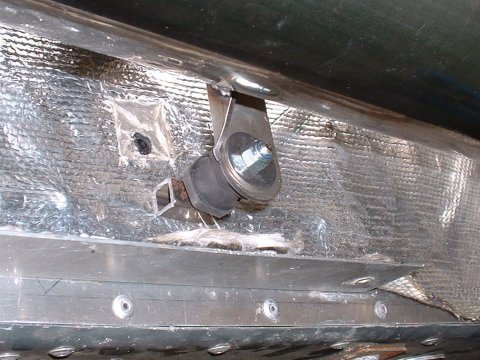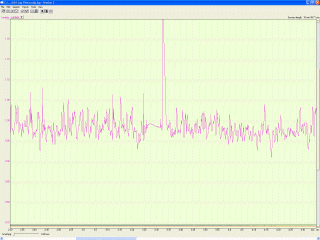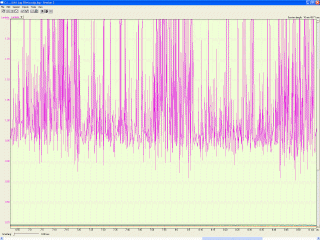home
introduction
build
sva tests
links
latest updates
August 1
- getting high tech -
Tim came round a few days ago, and we poked an oscilloscope at various potential offenders, such as the Crank Position Sensor and the injectors. All gave a clean bill of health. The conclusion of the evening was that everything was fine, except that fuel was no longer getting to the cylinders.
Subsequently, I tested the fuel pressure, and during this process, I found that the tank had run completely dry, which explains why the engine had stopped running altogether  . A fresh batch of fuel, and the engine ran fine - in fact, I've never heard it run better.
. A fresh batch of fuel, and the engine ran fine - in fact, I've never heard it run better.
August 2
- trying to set the fuelling -
Today, full of optimism, I went out to the garage to set the fuelling for emissions.
The engine still ran fine whilst warming up, but after it was fully hot, it occasionally misfired. Twice, it stalled completely, coinciding with the fan kicking in.
Still, it ran well enough to have a good stable lambda reading, which I was able to tweak to centre just about 1.0. But whilst the fan is running, the reading drops to 0.96
Which is strange.
If I had to rationalise a change, it would be an an increase, as the fan sucked up electrons and left the injectors with less of them.
The image below shows a typical section of the log of the session. On the left side, it's running at idle, centred slightly below 1.0. Then the fan kicks in and the engine stalls. A spike as I restart, and then it settles to a lower value as the fan continues to run
And fast idle? A joke. Massive lean spikes.
August 6
- trying to set the fuelling again -
Cam7 suggested that the richer running when the fan kicks in is the ECU (over)compensating for the drop in voltage. Since the voltage shouldn't really drop that much, they've ordered me to fit a new battery. They've also ordered me to make sure there's a good earth from the engine to the chassis. They've also ordered me to replace the regulator, but I really don't want to as it was bought new, and I've still not proved that it's the most likely cause of woe.
A friend, Greg, has also emailed me with some suggestions. In particular, he's confirmed a suspicion I've got - the lean spikes at fast idle could well be due to one of the cylinder misbehaving, rather than an electrical problem. A duff regulator, for example, would cause all the cylinders to misbehave.
Before investigating these things further, I measured the voltage that the ECU sees, and it was a touch low. I disconnected the little bulb that tells me the ECU is on, and got a little bit more voltage for the ECU. I disconnected the ignition light and got a bit more. I changed to the new battery, and got a lot more (we're up to 12.5 volts now, from 11.2)
Next, I stuck on a starter cable from the engine to the chassis to act as good earth.
I tested the regulator diodes - they're all as expected. I retested the alternator coils - they're all well within spec.
Running the engine, I get a good solid 13.8V across the battery, at all revs. With the previous battery, the voltage wasn't even making it to 13V. So it would seem that Cam7 are at least a little bit right.
Poking the multimeter around at various connections, everything seems in order, so I turn my attentions to lambda readings
And, a bit of a relief, we seem to be at a good stable platform to work from. The lambda reading is unaffected by the fan kicking in. Hopefuly we've eliminated any electrical problems.
After quite a time of trying to fiddle with fuelling at normal and fast idle, I come to realise that I'm not going to win though - there's still something wrong. Normal idle seems to be good and stable, but at fast idle there are still a plentitude of lean spikes - nothing like as bad as the previous graph, but still pretty bad.
I decide that the next thing to do is get some more petrol, and do some more investigating tomorrow
August 7
- trying to set the fuelling again -
Today's stroke of inspiration was to disconnect each injector in turn whilst running the lambda logger, and observe the effect. Once I turn off the one that's causing the lean spikes, I should get a stable reading - brilliant, huh?
It so nearly worked out that way as well - what I actually found was that whilst disconnecting most of the injectors caused a big increase in lamdba (engine appearing to run much leaner due to excess oxygen coming from the unfuelled cylinder), disconnecting #3 made almost no difference. The conclusion I drew from that was that some, but very little fuel was getting into the cylinder
I found this a bit weird, as the temperature of each exhaust header (measured using an infrared remote thermometer thingy) was the same.
There was no reduction in spikiness.
Anyway, I swapped the injectors for #2 and #3 around, and found to my surprise that now all were behaving the same - disconnecting any one injector causes the lambda reading to go very lean. Slightly worryingly, not each by the same amount, but definitely by a healthy amount. I'm hoping this means that there was some sort of blockage or goop stuck in #3, which has now been dislodged. As for the difference between the readings per injector, I'm hoping that's due to the position of the lambda sensor - I'll investigate that another time
OK - let's look at fuelling again. Normal idle, no problem, I have a stable lambda value, I fiddle with the numbers and the lambda goes where I want it.
But fast idle - woe, woe, woe. We still have lean spikes, but in a curious pattern - there's a cluster of them for 5-10s, every 30s or so. I stare despondently at the lamdba log scrolling past, and the pattern starts to get less clear - the spikes clusters get closer together, merging into one continuous spikey mess
But after a few minutes I notice an interesting thing. A spike cluster always preceeds the fan kicking in. Once the fan turns on, the spikes vanish, until the fan turns off, when they come back. As the engine has been running now for about an hour, the fan is kicking in more and more often to control the temperature, which could be why the spikes clusters are getting closer together.
The most obvious candidate is the Crankydash - it's the only device which can know that the fan is about to kick in, because it's the thing that controls it. But disconnecting it makes no difference.
But then something else happens. As the fan is not under automatic control, I switch it to continous operation, and the spikes vanish (theres just a very occasional short spike). Turning the fan off, they come back, and don't go away. I turn the headlights on, and the spikes vanish completely. Not a hint of a spike.
So it would seem that the spikes aren't a pre-cursor to the fan turning on - they're always there, but turning the fan on supresses them. Turning on the lights, and increasing the load supresses them further.
I've asked Cam7 for their opinion, but I suspect they're going to blame the regulator.
What I'd really like to be able to do is log the voltage and confirm that the lean spikes coincide with a voltage fluctuation, and then trace the cause of the fluctuation. William's LM-1, which I'm using to log the lambda stuff appears to have the capability to do this, but isn't currently set up for it. I'd better ask him before I fiddle with it...
August 8
- trying to set the fuelling again -
I rang Hallens today to order a new regulator, and was a little gob-smacked to discover it would be £141. I think, for now, I'll stick to the strategy of keeping the lights on whilst doing the emissions test.
No other bad news to report today though. I went out to the garage to set the fuelling, and the fuelling was set. Only tricky thing was that everytime I increased or decreased the fuelling at a given engine speed, the engine would change speed. Grrr.
August 21
- new regulator -
I bought a K1 regulator (from an 8000 mile bike) off eBay a couple of weeks ago, and thought I'd try it out instead of the new K2 one I bought before. No hints of any spikes, so I'll use the new (old) one and keep the old (new) one as a spare.
August 27
- monster bobbin -
Today, for the first Saturday in as long as I can remember, I headed out to the garage instead of the office. 2 hours later, the exhaust was mounted using a monster bobbin I'd snaffled from Steve's Emporium. The bobbin is bolted directly to the passenger side panel, and does a pretty good job of restraining the exhaust, but I thought there was a bit too much flex in the panel (which is only thin aluminium), so I used a conventional bobbin with a little foot on the end to stabilize the exhaust via the bottom mounting hole. It just rests on the side of the car, but should be just enough to stop the can rotating about the top mount.


This page last updated on: Thursday, Aug 24 2006
Component
january 04
february 04
march 04
april 04
may 04
june 04
july 04
august 04
september 04
october 04
november 04
december 04
january 05
february 05
march 05
april 05
may 05
june 05
july 05
august 05
november 05
december 05
january 06
march 06
april 06
august 06

